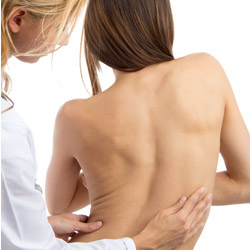We’ve all heard the medical term scoliosis and some of you may have even been told you have it. But what is it exactly? And what is an effective scoliosis treatment?
Scoliosis is the term used to describe a lateral curvature of the spine. This means that your spine is at some point deviated to the left or right – rather than straight down. You can have a ‘C’ curved deviation or an ‘S’ curved deviation.
What Causes Scoliosis?
Scoliosis has no single cause. It can be caused by many things. There are two classifications of scoliosis – structural and functional.
A structural scoliosis, can be caused by fractures in the spine or other similar injuries that result in a wedging pattern.
The most common type of scoliosis is idiopathic scoliosis common in adults and teens. This is most commonly associated with poor postural habits or uneven muscle growth due to things like one sided sports eg tennis or hockey. This type of scoliosis is often only 5-10o, but may curve up to 20-25o, and may only be noticeable in some positions eg bending forward. We call this a functional scoliosis.
For some people, scoliosis is a genetic condition and will usually present in early childhood or early teenage years. This type of scoliosis, referred to as juvenile scoliosis, is usually caused by a neuro-muscular defect which causes the muscles on the side of the spine to shorten. Unfortunately, this type of scoliosis can change quickly to become a serious health issue.
C Curved Scoliosis and S Curved Scoliosis
Below is a drawing I did, showing the difference between each spinal curves:
Treating Scoliosis
Curves over 20o need to be monitored for change, as these curves may start to impact on the thorax (your chest) and its internal organs. Osteopathic scoliosis treatment may include manual therapy, such as osteopathy, specific strength exercise, braces and if severe, spinal surgery. If you believe your child has a curve that is quickly becoming more pronounced, please see your GP or osteopath.
In most cases of functional scoliosis a manual therapist such as an osteopath can help. These types are often caused by poor posture which results in shortening of large muscle groups and imbalances in the pelvis and spine.
In addition to manual treatment techniques, an osteopath will be able to identify the pattern and help you to recognise the activities that may be contributing to your condition and tailor a treatment and exercise program to help strengthen and straighten your spine.
For more information, or to chat about how we can help with you with our scoliosis osteopath treatments, contact Inlign Osteopathy.



